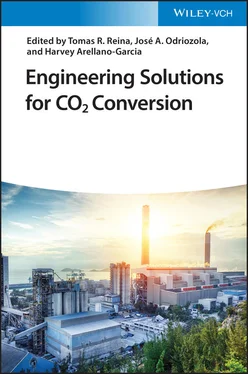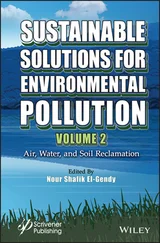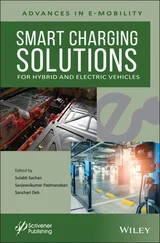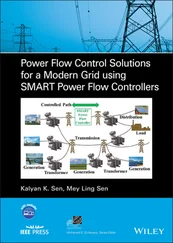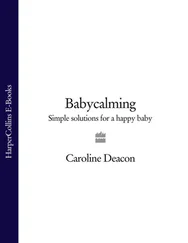Finally, the entirety of the absorber is considered at the full scale. The pressure coefficients calculated at the REU scale are the link between the latter and the full scale and are therefore introduced in the full‐scale simulations as an additional momentum sink in Eq. (2.2). The final outcome from this multi‐scale approach was the velocity field within the absorber, with the objective of avoiding the possibility of flooding and selecting the most appropriate gas distributor so as to minimize strong velocity gradients.
Other multi‐scale strategies have followed in order to model amine scrubbers, such as that presented by Sun et al. [11], who proposed a two‐scale approach partially based on CFD. At the REU‐scale three‐dimensional (3‐D) multiphase (gas and liquid), CFD simulations of a limited set of REUs of the commercial packing Mellapak 350X were used to obtain the stream split fraction coefficients and the effective wetted area ratio as a function of the liquid flow rate. The authors distinguished between four REU types, namely, inlet of the column, outlet, wall, and interior. From that stage, they mapped the entire set of REUs within the column, assigning an identifier based on their location and subsequently, introduced the parameters from the small‐scale calculations mentioned above into a mechanistic model. The final output was the liquid hold‐up distribution across the entire column, which is necessary to obtain the wet pressure drop by means of experimental correlations. Although not entirely based on CFD, the scale‐based approach reported by Sun et al. [11] proved that multiphase simulations with gas–liquid interface tracking via the VOF method are possible with the advent of computational capabilities with increased power. The use of the computationally costly VOF method was not restricted to 2‐D simulations at the corrugation level or 3‐D simulations over a simple inclined plate, but at the REU scale.
A number of other models falling under the umbrella of one of the three scales presented by Raynal and Royon‐Lebeaud [6] can be found in the literature, showcasing interesting characteristics of the flow within an amine scrubber. At the corrugation scale 2‐ and 3‐D simulations featuring the VOF algorithm have been used to study the fundamental hydrodynamics of rivulets and droplets. Some attempts to introduce the chemistry between carbon dioxide and the amine have also been reported in 2‐D by Haroun et al. [12] and in 3‐D by Sebastia‐Saez et al. [13]. At the REU scale, most of the studies have focused on obtaining the dry pressure drop of the packing, where an accurate selection of the appropriate turbulence model is crucial [14]. Finally, at the full scale, a big step forward has been taken by introducing the multiphase reactive flow on the porous Euler‐Euler approach. To accomplish this, Pham et al. [15] introduced mass and momentum source terms added to the Navier–Stokes equations. These are the terms marked as S massand S momin Eqs. (2.1)and (2.2), respectively, to account for the anisotropy of the packing. To include these source terms in the calculation, one can make use of a user‐defined function, like those used in commercial software such as ANSYS Fluent, or directly code their defining equations in an open‐source CFD software such as OpenFOAM or an in‐house code. The momentum source terms were accounted for the loss of momentum on both the liquid and the gas phase caused by the porous resistance, momentum exchange between both phases and liquid dispersion. For a complete description of the momentum source terms, the reader is referred to the work of Pham et al. [15]. Table 2.1gathers information on CFD models related to amine scrubbers in terms of the scale used and the conclusions reached.
Table 2.1Summary of published CFD studies concerning amine scrubbers.
| Authors |
Simulation scale |
Aspect studied |
Short comment on conclusions |
| van Baten et al. [16] |
REU (intermediate scale) |
Quantification of axial and radial liquid dispersion on KATAPAK‐S commercial structured packing |
Enhanced axial dispersion in the case of KATAPAK‐S relative to common packings |
| Petre et al. [17] |
REU (intermediate scale) |
Description and quantification of the main contributions to dry pressure drop |
The most significant causes of pressure loss are elbow effect and jet splitting at packed bed entrance, elbow effect at column walls, elbow effect at layer transitions, and collision at crisscross junctions |
| Raynal et al. [18] |
REU (intermediate scale) |
Multi‐scale REU + corrugation scale study |
Combining dry pressure drop from 3‐D REU‐scale and liquid hold‐up from 2‐D corrugation scale is a successful strategy to match wet pressure drop data obtained experimentally |
| Fernandes et al. [19, 20] |
REU (intermediate scale) |
Study of dry and wet pressure drop in a considerable number of REUs (whole column section) |
The geometry used encompasses one of the largest sets of REUs found in the literature along with that represented by Isoz and Haidl [21]. Wet pressure drop obtained assuming fully developed film flow over the entire packing surface |
| Armstrong et al. [22] |
REU (intermediate scale) |
Effect of corrugation angle and F ‐factor on dry pressure drop caused by friction |
Adding the effect of corrugation angle in correlations improves dry pressure drop predictions |
| Owens et al. [23] |
REU (intermediate scale) |
Optimization of computational resources to simulate more effectively at the REU scale. Use of X‐ray computer tomography to generate geometries |
Number of REU considerably increased to include half an element of Mellapak N250Y |
| Haroun et al. [24] |
REU (intermediate scale) |
Gas–liquid interface tracking in four REU geometries. Their approach constitutes a step forward toward integrating the corrugation and REU scales |
Not only is the REU scale valid for representing the dry pressure drop per unit length but also the interface area versus liquid flow rate |
| Lautenschleger et al. [25] |
REU (intermediate scale) |
Single‐phase (gas) flow characteristics of novel packing PD‐10 |
Optimization of packing geometry to reduce pressure drop without jeopardizing mass transfer |
| Sebastia‐Saez et al. [26] |
REU (intermediate scale) |
Characteristics of multiphase gas–liquid flow on a limited set of REUs |
Dependence between liquid flow rate and both gas–liquid interface area and liquid hold‐up successfully represented in a set of four REUs |
| Li et al. [27] |
REU (intermediate scale) |
Transition between corrugation and REU scale |
Wet pressure drop and liquid hold‐up complemented with data obtained at the corrugation scale |
| Isoz and Haidl [21] |
REU (intermediate scale) |
Parametric study on the effect of slope of packing channels among others on the dry pressure drop. The authors used the imaging software Blender to obtain accurate representations of the column inner intricacies |
Largest set of REUs along with that presented by Fernandes et al. [19, 20] |
| Yang et al. [28] |
REU (intermediate scale) |
Multiphase VOF gas–liquid flow within three piled REUs of Mellapak 250 Y. The work focuses on the effect of liquid flow patterns on the formation of dead zones |
Portion of dead zones increased at high values of the Weber No. Wetted area highly affected by liquid flow rate but not by gas flow rate. The latter affects film stability and droplet formation |
| Asendrych et al. [29] |
Full scale |
Operating parameters including profiles of velocity of both phases, pressure liquid hold‐up, and species concentration by using the Euler–Euler multiphase method + mass source terms for chemical reactions |
The model was validated in terms of CO 2capture efficiency by comparison to own experimental data |
| Niegodajew and Asendrych [30] |
Full scale |
Parametric 2‐D study of the entire column using the full‐scale porous medium approach |
There is a mild effect of the carbon dioxide concentration at inlet conditions on the capture efficiency, which highlights the suitability of amine scrubbing on diverse scenarios (change of fuel, etc.) |
| Kim et al. [31] |
Full scale |
Effect of four modification factors in the Ergun equation related to the liquid hold‐up and the liquid load in order to determine the pressure drop |
Good match between simulation and experimental results in terms of carbon dioxide conversion, wet pressure drop, and hold‐up using the new factors in the Ergun equation |
| Gu et al. [32] |
Corrugation scale (small scale) |
2‐D study of the effect of corrugation geometry on the hydrodynamics of liquid films |
Research on surfactants and treatment of packing surface are crucial to obtain desired film flow patterns |
| Valluri et al. [33] |
Corrugation scale (small scale) |
2‐D multiphase study of gravity‐driven liquid films flowing down a corrugated textured solid surface (Mellapak) at low Reynolds numbers |
The ratio between gas–liquid interface and specific packing area diminishes with increased surface roughness |
| Ataki and Bart [34] |
Corrugation scale (small scale) |
Morphology of rivulets in Rombopak 4M |
Simulations used to develop or modify the degree of wetting, liquid hold‐up, and effective area |
| Haroun et al. [35] |
Corrugation scale (small scale) |
2‐D direct multiphase simulation of the formation of liquid recirculation areas in packing corrugation and its effect on mass transfer |
Recirculation areas substantially affect the liquid hold‐up (liquid dead zones). Mass transfer not affected by the formation of recirculation areas |
| Iso et al. [36] |
Corrugation scale (small scale) |
Study of the effect of packing texture patterns on the gas–liquid interface area |
To place ridges perpendicularly to the flow direction results in enhanced gas–liquid interface area |
| Sebastia‐Saez et al. [37] |
Corrugation scale (small scale) |
Study of the hydrodynamics of rivulet instabilities (braiding) |
Braiding caused by interplay between surface tension and inertia and results in reduced interface area. Packing texture must be designed to hamper the effect of surface tension |
